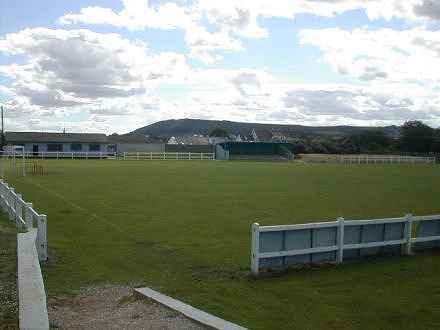The street on the opposite side of the hill, which now leads into the
G.A.A. and Pitch and Putt was East Barrack Street. Now called
St Colmcille Street,
it was also very busy and had five pubs, a restaurant and many other homes and businesses.
The little street connecting with Bachelor’s Walk
was called Mess House Lane. This little street had about twenty-four houses and was
very overcrowded.
|
 Colmcille Street from East Barracks Colmcille Street from East Barracks |
 Mess House Lane to Bachelor's Walk Mess House Lane to Bachelor's Walk |
The back entrance to the
East Barracks was at the top of Greenhill
and it was through this entrance that most of the supplies were delivered.
This was quite considerable
and kept many businesses alive in the town.
In the year 1909
the total complement of military in this barracks was
112 officers, 1,478 non-commissioned officers and privates,
24 cavalry officers and 120 cavalry troopers.
On the west side of
Barrack Hill where Sheare’s Street is now, used to be
West Barrack Lane. Then turn up Barrack Road which led up to the side entrance of the
West Barracks and also to the Poor Law Burial Ground now known as the
Famine Graveyard and to the
Military Cemetery.
|
This area is today adjacent to the Fermoy Soccer Club’s ground.
The most outstanding building in Barrack Hill must be the
Church of Ireland church, which was built on a beautiful south facing site at the junction
of the Mallow and Dublin Roads. It is interesting to know that the streets adjacent
to this Church are called Church Place and Church Hill, whereas the streets adjacent to
the Catholic Church are called Chapel Hill and Chapel Square indicating that the
Catholic Church was called a chapel and the Protestant Church was called a church.
|
 Fermoy Soccer Club Fermoy Soccer Club |
 St Frances Welfare Home St Frances Welfare Home |
You will now move southwards into King’s Square now known as
Brian Boru Square where, on the right hand side
you have the beautiful Fermoy House and its magnificently kept gardens and lawns,
(the latter are now known as the Fermoy Town Park. To the south you have
King’s Inch which is the inch along the north bank of the beautiful Blackwater River.
On the east side of Kings Square lies Frances Street.
A number of important buildings of social interest were in this area, for example, the
Assembly Rooms (presently Batavia furniture store) which was a music theatre
for many years and it was also the hall and Cinema where the first silent films were shown
in Fermoy. Forristal’s Coach House or Hotel was also situated on Frances Street where
St. Frances Welfare Home now stands.
|
|
You now move across from King’s Square over the then newly built bridge (a timber bridge had
been built over the Blackwater in 1626), and
approach Queen’s Square which was later re-named
Pearse Square.
This Square has always been considered the central point of the town, where many markets and
horse fairs were held long before the days of the marts. On the southern side of
Queen’s Square lies the hill of St. John. It was on this hill that the two convents,
St.Colmans College, and the Bishop's House were built.
|

Pearse Square |

